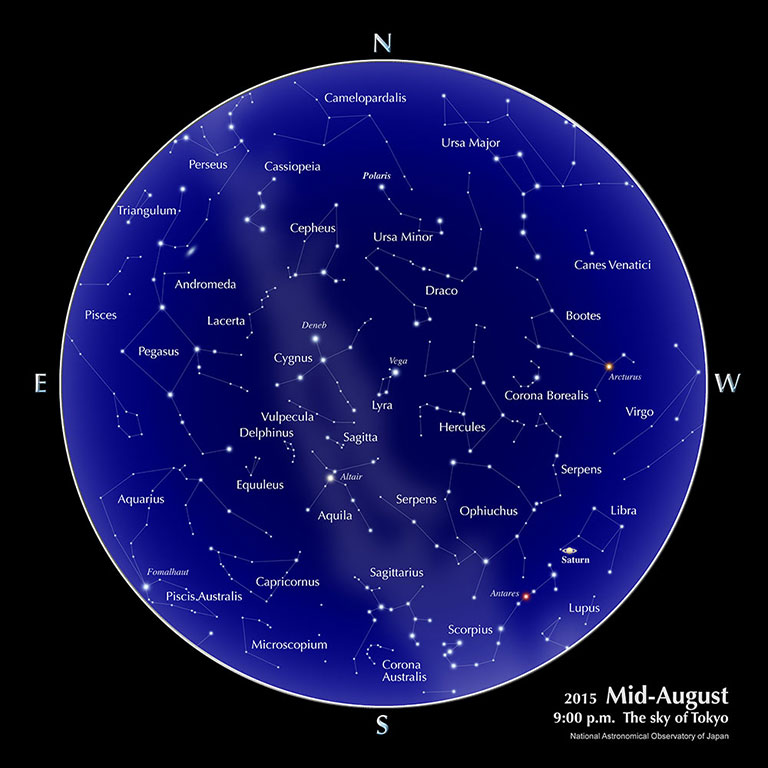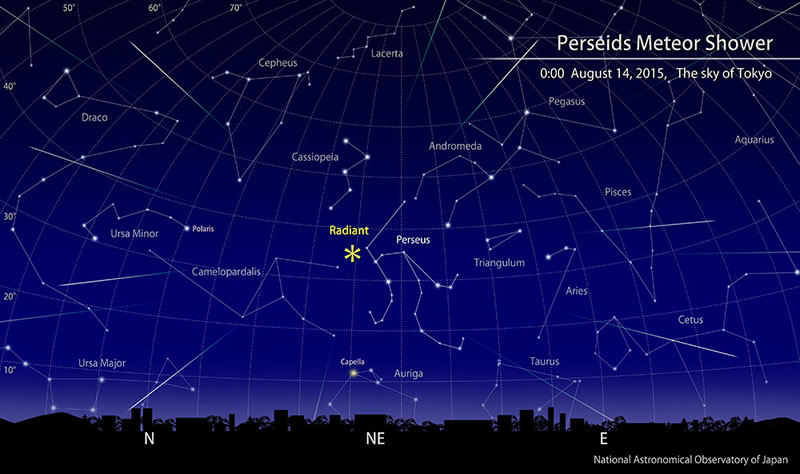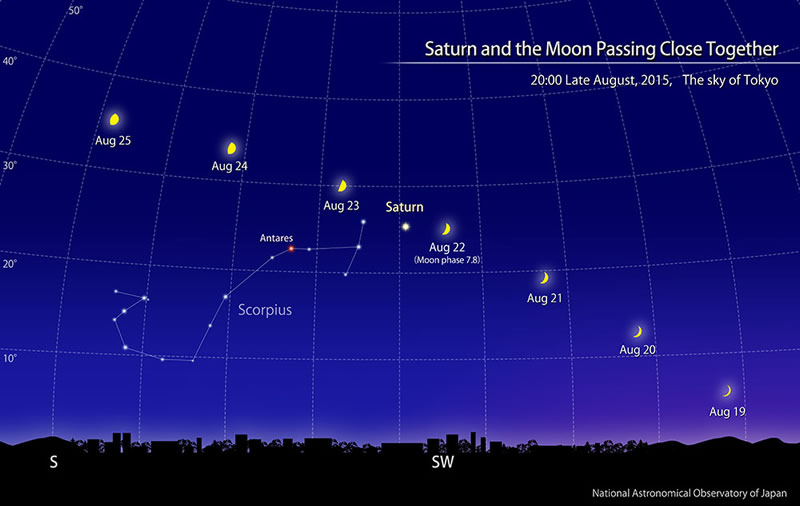August, 2015
Index
The sky of Tokyo

Calendar (August)
| 3 | Saturn at stationary point |
| 7 | Last Quarter |
| 13 | 13(th) Peak of Perseids Meteor Shower around 3:30 p.m. (the peak time is day time, but the condition is good because there is no effect of moonlight in the night.) |
| 14 | New Moon |
| 16 | Venus at inferior conjunction |
| 20 | Traditional tanabata (traditional star festival) |
| 23 | First Quarter |
| 27 | Jupiter at conjunction |
| 30 | Full Moon |
The posted peak day and time of meteor showers is based on the prediction of IMO(International Meteor Organization).
Planets
- Mercury
- In the beginning and middle of the month, Mercury appears near the Sun, making observation difficult. At the end of the month, its elevation gradually increases in the western evening sky. Mercury reaches its greatest eastern elongation on September 4, but even then its elevation isn’t very high, making it difficult to observe.
- Venus
- In the beginning and middle of the month, Venus appears near the Sun, making observation difficult. It reaches inferior conjunction on the 16th. Near the end of the month, Venus can be seen low in the eastern sky around dawn and its elevation increases day by day. At the end of the month, its brightness is -4.3 magnitude.
- Mars
- Mars moves from the constellation Gemini into the constellation Cancer. It is low in the predawn eastern sky, but because it appears near the Sun and its brightness is dim, approximately 2 magnitude, observation is difficult.
- Jupiter
- Jupiter, located in the constellation Leo, reaches conjunction on the 27th. It appears near the Sun, making observations difficult.
- Suturn
- Look for Saturn, located in the constellation Libra, in the southwestern sky after sunset. The brightness is 0.4 magnitude to 0.5 magnitude.
Source: Ephemeris Computation Office, NAOJ
With the “Sky Viewer” you can easily explore the appearance of a typical urban night sky (planets and constellations are visible).The Celestial Phenomenasection of the glossary explains the planetary phenomena terms: greatest elongation, opposition, conjunction, stationary, etc.
Topics
Every year, August 1-7 is “Star Week: a Week to Appreciate the Starry Sky.”
Star Week is a campaign to familiarize a wide range of people from children to adults with the starry sky. During the children’s summer vacation, it is possible to stay up a little later. Please take this chance to look at the starry sky.
Events like star gazing are held throughout Japan in cooperation with Star Week.
Link
- Star Week (Japanese Only)
Perseids Meteor Shower

The Perseids meteor shower is predicted to be active from midnight on August 12 until dawn on August 14.
The Perseids are a meteor shower active every year centered on August 12, 13.
This year the maximum (peak activity) is predicted to occur around 15:00 on the 13th. The maximum occurs during the daytime in Japan. But because the 14th is the new moon, the preceding and following nights will be unaffected by moonlight, so it should be possible to see even faint meteors. Therefore, many meteors can be expected from midnight on the 12th until dawn on the 13th and from midnight on the 13th until dawn on the 14th. If you watch from a location with a dark sky, you can probably see more than 30 meteors per hour.
The Traditional Tanabata
The traditional Tanabata (“Seventh Evening”), a classical star festival, is the 7th day of the 7th month of the luni-solar calendar (the old calendar). The Tanabata stars climb high in the evening sky this day as the waxing crescent moon shines brightly in the southwestern sky.
In the modern calendar, the day corresponding to the traditional Tanabata changes each year. This year, the traditional Tanabata falls on August 20.
Look for Ori-hime “the Weaving Princess” (Vega, a 1st magnitude star in the constellation Lyra) and Hikoboshi “The Lad Star” (Altair, a 1st magnitude star in the constellation Aquila). From a spot with a dark sky you can also see “the River of Heaven” (the Milky Way).
The “Traditional Tanabata Light-Down Campaign” was started in 2011 to extinguish unnecessary lights and look at the starry sky around the time of the traditional Tanabata.
References:
- Traditional Tanabata Light-Down Campaign (Japanese Only)
Saturn and the Moon Passing Close Together

Saturn appears in the southwestern sky after sunset. Antares, a 1st magnitude star in the constellation Scorpius, can be found to the east of Saturn. The brightness of Antares is 1 magnitude and Saturn is even brighter, 0th magnitude. Antares is a red star; the red color can be discerned by comparing it to other stars.
From the 21st to the 24th, the Moon passes close to Saturn and Antares. The Moon appears closest to Saturn on the 22nd and approaches Antares on the 23rd. Because the Moon is at first quarter on the 23rd, it is not as bright as a full moon. You can enjoy the sight of the Moon lining up beautifully with Saturn or Antares. Please take a look.